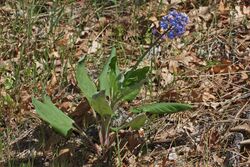Biology:Cynoglossum grande
| Cynoglossum grande | |
|---|---|

| |
| Scientific classification | |
| Kingdom: | Plantae |
| Clade: | Tracheophytes |
| Clade: | Angiosperms |
| Clade: | Eudicots |
| Clade: | Asterids |
| Order: | Boraginales |
| Family: | Boraginaceae |
| Genus: | Cynoglossum |
| Species: | C. grande
|
| Binomial name | |
| Cynoglossum grande Dougl. ex Lehm.
| |
Cynoglossum grande is a species of flowering plant in the borage family known by the common name Pacific hound's tongue. It is native to western North America from British Columbia to California , where it grows in shady areas in woodland and chaparral. On the forest floor of California oak woodlands typical plant associates are Calochortus luteus, Delphinium variegatum and Calochortus amabilis.[1] It is a perennial herb producing an erect stem 30 to 90 centimeters tall from a taproot. The leaves are mostly located around the base of the plant, each with an oval blade up to 15 centimeters long held on a petiole. The inflorescence is a panicle of flowers on individual pedicels. Each five-lobed flower is bright to deep blue with white appendages at the center. It is 1 to 1.5 centimeters wide. The fruit is an array of four slightly bristly nutlets.[2]
Notes
References
- C. Michael Hogan. 2009. Gold Nuggets: Calochortus luteus, GlobalTwitcher.com, ed. N. Stromberg
- Jepson Manual. 1993. Cynoglossum grande
- Larry Ulrich. 2002. Wildflowers of Henry W. Coe State Park
External links
- Calflora Database: Cynoglossum grande (Pacific hound's tongue, Western houndstongue)
- USDA Plants Profile for Cynoglossum grande
- UC Photo gallery − Cynoglossum grande
Wikidata ☰ Q5199963 entry

